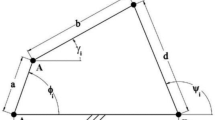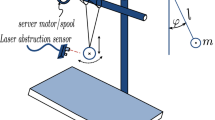Abstract
The paper presents a novel hybrid CHAOS-PSO algorithm for dimensional syntheses of redundant manipulators while not following common design principles of arm length or arm length ratio of a human in previous literatures. More specifically, we employ the clamping weighted least-norm (CWLN) method to solve inverse kinematics of the redundant manipulator tracking desired nonsingular or singular trajectories considering joint limits. Thus, an optimal solution of flexible D-H parameters of manipulator is explored in the search space based on evaluations by the defined fitness functions with the proposed algorithm. As an optimization tool in this work, the hybrid CHAOS-PSO algorithm incorporates chaos into the particle swarm optimization (PSO) algorithm as population initialization and global perturbation technique in order to enhance swarm diversity and escape from premature convergence. To demonstrate validity and practicability of the proposed algorithm compared to PSO, simulations of dimensional syntheses of a 7-degree-of-freedom (7-DOF) redundant manipulator with complex structures along the planed nonsingular or singular trajectories are performed.












Similar content being viewed by others
References
Ozgoren MK (2013) Optimal inverse kinematic solutions for redundant manipulators by using analytical methods to minimize position and velocity measures. ASME J Mech Robot 5(3):031009-031009-16
Rodic A, Miloradovic B, Popic S et al (2015) On developing lightweight robot-rrm of anthropomorphic characteristics. In: New Trends in Medical and Service Robots, Part of the Mechanisms and Machine Science. Springer, Cham, pp 33–46
Lee DH, Park H, Park JH et al (2017) Design of an anthropomorphic dual-arm robot with biologically inspired 8-DOF arms. Intel Serv Robot 10(2):137–148
Rader S, Kaul L, Fischbach H et al (2016) Design of a high-performance humanoid dual arm system with inner shoulder joints. In: Pro. IEEE 16th International Conference on Humanoid Robots (Humanoids), Cancun, Mexico, 523–529
Lenarcic J, Umek A (1994) Simple model of human arm reachable workspace. IEEE Trans Syst Man Cybern 24(8):1239–1246
Jin Y, Bi ZM, Liu HT et al (2015) Kinematic analysis and dimensional synthesis of exechon parallel kinematic machine for large volume machining. ASME J Mech Robot 7:041004-1041004-8
Huang T, Li M, Li ZX et al (2004) Optimal kinematic design of 2-DOF parallel manipulators with well-shaped workspace bounded by a specified conditioning index. IEEE T Robotic Auto 20(3):538–543
Li M, Huang T, Mei JP et al (2005) Dynamic formulation and performance comparison of the 3-DOF modules of two reconfigurable PKM-the Tricept and the TriVariant. ASME J Mech Design 127:1129–1136
Pievatolo A, Rotondi R (2004) Dual quaternion synthesis of constrained robotic systems. ASME J Mech Design 126:425–435
Maurice P, Padois V, Measson Y et al (2017) Human-oriented design of collaborative robots. Int J Ind Ergonom 57:88–102
Singla E, Tripathi S, Rakesh V et al (2010) Dimensional synthesis of kinematically redundant serial manipulators for cluttered environments. Robot Auton Syst 58(5):585–595
Hussain S (2017) Fault diagnosis of gearbox using particle swarm optimization and second-order transient analysis. ASME J Vib Acoust 139(2):021015-021015-7
AI-Ani D, Habibi S (2013) A new particle swarm optimization and differential evolution technique for constrained optimization problems. In: Proc. ASME International Mechanical Engineering Congress and Exposition, San Diego, California, USA, V04AT04A084
Liu B, Wang L, Jin YH et al (2005) Improved particle swarm optimization combined with chaos. Chaos Soliton Fract 25(5):1261–1271
Alrasheed MR, Silva CWD, Gadala MS (2007) A modified particle swarm optimization scheme and its application in electronic heat sink design. In: Proc. ASME 2007 InterPACK Conference collocated with the ASME/JSME 2007 Thermal Engineering Heat Transfer Summer Conference, Vancouver, British Columbia, Canada, 627–636
Huang SH, Peng Y, Wei W et al (2016) Clamping weighted least-norm method for the manipulator kinematic control with constraints. Int J Control 89(11):2240–2249
Chiaverini S (1997) Singularity-robust task-priority redundancy resolution for real-time kinematic control of robot manipulators. IEEE T Robotic Auto 13(3):398–410
Dorigo M (1992) Optimization, learning and natural algorithms. Dissertation, Politecnico di Milano
Acknowledgements
The authors would like to acknowledge the financial supports of the National Natural Science Foundation (Grant no. 51706098, 51375230) and the Natural Science Foundation of Jiangsu Province (Grant no. BK20170792, BK20170315).
Author information
Authors and Affiliations
Corresponding author
Rights and permissions
About this article
Cite this article
Wan, J., Ding, L., Yao, J. et al. A hybrid CHAOS-PSO algorithm for dimensional synthesis of a redundant manipulator based on tracking trajectories without or with singularities. Prod. Eng. Res. Devel. 12, 579–587 (2018). https://doi.org/10.1007/s11740-018-0837-9
Received:
Accepted:
Published:
Issue Date:
DOI: https://doi.org/10.1007/s11740-018-0837-9




